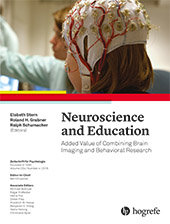Proportional Reasoning
The Role of Congruity and Salience in Behavioral and Imaging Research
Abstract
Abstract. Comparison of ratios is difficult for children and adults. We studied the role of salience and congruity in comparison of ratios using reaction time and functional magnetic resonance imaging (fMRI). Participants were asked to decide which of two mixtures of red and white paint drops (presented in Arabic numerals) was darker. In congruent trials the mixture with more red drops was darker and in incongruent trials it was lighter. Half of the trials were red salience (more red than white drops in both mixtures) and half of them were white salience. Interaction between congruity and salience was observed. Behaviorally, accuracy was higher and reaction time of correct responses (RTC) was shorter in congruent red salience and incongruent white salience conditions. For these conditions higher activation in a fronto-parietal numerical network was observed in fMRI. These findings suggest that automatic processing of natural numbers supports or suppresses the comparison of ratios as a function of congruity and salience.
References
(2011). Is 2 + 2=4? Meta-analyses of brain areas needed for numbers and calculations. NeuroImage, 54, 2382–2393. doi: 10.1016/j.neuroimage.2010.10.009
(2006). Intuitive interference in probabilistic reasoning. International Journal of Science and Mathematics Education, 4, 627–639. doi: 10.1007/s10763-006-9031-1
(2016). Comparison of perimeters: Improving students’ performance by increasing the salience of the relevant variable. ZDM Mathematics Education, 48, 367–378. doi: 10.1007/s11858-016-0766-z
(2007). The mental representation of numerical fractions: Real or integer? Journal of Experimental Psychology: Human Perception and Performance, 33, 1410–1419. doi: 10.1037/0096-1523.33.6.1410
(1996). AFNI: Software for analysis and visualization of functional magnetic resonance neuroimages. Computers and Biomedical Research, 29, 162–173. doi: 10.1006/cbmr.1996.0014
(2011). The number sense: How the mind creates mathematics. New York, NY: Oxford University Press.
(1995). Towards an anatomical and functional model of number processing. Mathematical Cognition, 1, 82–120.
(1997). Cerebral pathways for calculation: Double dissociation between rote verbal and quantitative knowledge of arithmetic. Cortex, 33, 219–250. doi: 10.1016/S0010-9452(08)70002-9
(1987). Intuition in science and mathematics. Dordrecht, The Netherlands: Reidel.
(2003). Perceiving numbers causes spatial shifts of attention. Nature Neuroscience, 6, 555–556. doi: 10.1038/nn1066
(1983).
A survey of probabilistic concepts in 3000 students aged 11–16 years . In D. R. GreyP. HolmesV. BarnettG. M. ConstableEds., Proceedings of the First International Conference on Teaching Statistics (pp. 766–783). Sheffield, UK: Teaching Statistics Trust.(1958). The growth of logical thinking: From childhood to adolescence. New York, NY: Basic Books.
(2009). The processing and representation of fractions within the brain: An fMRI investigation. NeuroImage, 47, 403–413. doi: 10.1016/j.neuroimage.2009.03.041
(2009). Notation-independent representation of fractions in the human parietal cortex. The Journal of Neuroscience, 29, 4652–4657. doi: 10.1523/JNEUROSCI.0651-09.2009
(2009). A generalized fraction: An entity smaller than one on the mental number line. Journal of Experimental Psychology: Human Perception and Performance, 35, 1845–1864. doi: 10.1037/a0016892
(1983).
Proportional reasoning of early adolescents . In R. LeshM. LandauEds., Acquisition of mathematics concepts and processes (pp. 45–90). New York, NY: Academic Press.(2007).
Rational numbers and proportional reasoning: Toward a theoretical framework for research . In F. LesterEd., Second handbook of research on mathematics teaching and learning (pp. 629–668). Reston, VA: NCTM.(2009). Rational numbers: Componential versus holistic representation of fractions in a magnitude comparison task. The Quarterly Journal of Experimental Psychology, 62, 1598–1616. doi: 10.1080/17470210802511162
(1999). Developing children’s understanding of the rational numbers: A new model and an experimental curriculum. Journal for Research in Mathematics Education, 30, 122–147. doi: 10.2307/749607
(1980a). The development of proportional reasoning and the ratio concept (the Orange Juice Experiment). Part 1: The determination of stages. Educational Studies in Mathematics, 11, 217–253.
(1980b). The development of proportional reasoning and the ratio concept. Part 2: Problem structure at successive stages; problem-solving strategies and the mechanism of adaptive restructuring. Educational Studies in Mathematics, 11, 331–363.
(2013). Measuring the allocation of attention in the Stroop task: Evidence from eye movement patterns. Psychological Research, 77, 106–115. doi: 10.1007/s00426-011-0405-9
(2006). Development of intuitive rules: Evaluating the application of the dual-system framework to understanding children’s intuitive reasoning. Psychonomic Bulletin & Review, 13, 935–953. doi: 10.3758/BF03213907
(1985).
Cognitive processes and products in proportional reasoning . In L. StreeflandEd., Proceedings of the Ninth International Conference for the Psychology of Mathematics Education (pp. 352–356). Noordwijkerhout (Utrecht), The Netherlands: PME.(1976). Three aspects of cognitive development. Cognitive Psychology, 8, 481–520.
(2008). Complexity of shapes and quantitative reasoning in geometry. Mind, Brain, and Education, 2, 170–176. doi: 10.1111/j.1751-228X.2008.00051.x
(2010). Overcoming intuitive interference in mathematics: Insights from behavioral, brain imaging and intervention studies. ZDM Mathematics Education, 42, 621–633. doi: 10.1007/s11858-010-0251-z
(2006). Intuitive interference in quantitative reasoning. Brain Research, 1073–1074, 383–388. doi: 10.1016/j.brainres.2005.12.011
(2000). How students (mis-)understand science and mathematics. New York, NY: Teachers College Press.



